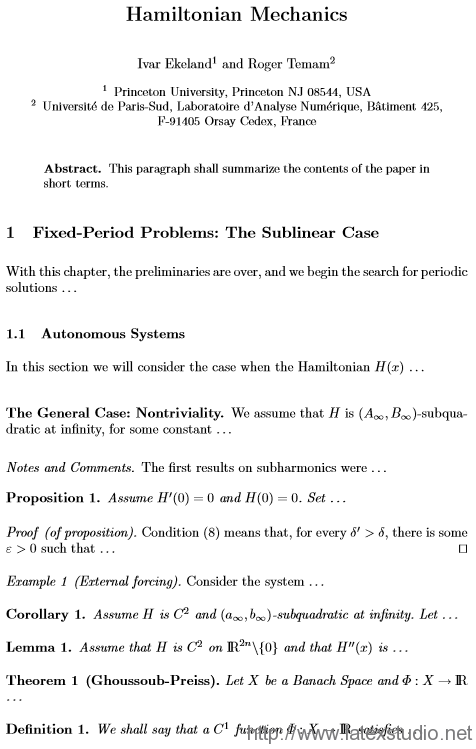| 模板文件 | 说明 |
|---|---|
| history.txt | 宏包的版本历史信息 |
| llncs.cls | 模板类文件 |
| llncs.dem | 一个编码的样例文件 |
| llncs.doc | 文档的指南,本文的源代码等等 |
| llncsdoc.pdf | 模板的使用指南PDF版本 |
| llncsdoc.sty | class modifications to help for the instructions |
| llncs.ind | 作者索引文件(模拟的) |
| subjidx.ind | 来自于Springer书宏包的主题索引演示样例 |
| llncs.dvi | 生成的DVI样例 |
| sprmindx.sty | 索引生成的补充宏包(使用方法: makeindex -s sprmindx.sty <yourfile.idx>) |
启用LLNCS 类
LLNCS 只是标准 LATEX “article” class 的拓展版本,所以在文章中可以使用所有 “article” 的语法。如果要使用 LLNCS class,则使用如下形式:
\documentclass{llncs}
%
\begin{document}
<Your contribution>
\end{document}文章已经用 LATEX 写好而未使用 LLNCS 格式的情况
请不要使用任何会影响文档布局或格式的 LATEX 或 TEX命令(即像 \textheight, \vspace, \headsep, etc)。然而,有可能会有例外的情况下,可以使用一些。
公式输入
公式会以您文章出现的顺序在右手边使用阿拉伯数字自动编号。当你的工作在数学模式时,都是用斜体字排版。有时候你需要插入非数学元素(例如单词或短语)。这种插入的代码应该使用 roman(即\mbox)如下例所示:
\begin{equation}
\left(\frac{a^{2} + b^{2}}{c^{3}} \right) = 1 \quad
\mbox{ if } c\neq 0 \mbox{ and if } a,b,c\in \bbbr \enspace .
\end{equation}如果你想在一个显示公式后立即开始新的段落,插入一个空白行,以产生所需的缩进。如果不插入一个空白行或代码 \noindent 会立即继续之前的文本而没有没有新的段落。
displayed 公式也使用相同的方式处理,其他普通文本则在结束本句前使用 \enspace。
注意括号的尺寸或其他分隔符必须保证是闭合的,使用下面命令可以保证:
\left( 或者 \left[ 和 \right) 或者 \right].
斜体和 Roman 体
在公式中,一般使用斜体,但下标应使用 Roman 体而不是斜体。
确保一些物理标记使用
\mathrm命令,如 Hz:\mathrm{Hz}。还有一些常用的数学函数,如 log,sin,exp,max和sup应该使用:\log,\sin,\exp,\max和\sup。化学式应该使用 Roman 体,如: H2O。
熟悉的单词或句子不应使用斜体,如: et al., a priori, in situ, bremsstrahlung, eigenvalues。
如何编辑输入代码
页眉部分
标题中的所有单词应该都大写,除了连词、介词 (例如 on, of, by, and, or, but, from, with, without, under) 还有定冠词和不定冠词 (the, a, an) 除非他们出现在开头,否则均小写。公式的字母必须在文本内排版。
大写和不大写
下面情况均需大写:
Headings。
文章中的缩写和表达式,如: Fig(s)., Table(s), Sect(s)., Chap(s)., Theorem, Corollary, Definition etc. 跟数字一起使用时,如: Fig.3, Table 1, Theorem 2。
下面情况不能大写:
在文章中,当 figure(s), table(s), equation(s), theorem(s) 等词没有与编号一起使用时。
图表图例和表格标题,除非是缩写。
词的缩写
下列词除非是出现在句子开头,否则在文章中应该使用缩写: Chap., Sect., Fig.。例如: The results are depicted in Fig.5. Figure 9 reveals that ….
注: 公式一般使用括号跟数字代替,但出现在句子开头时需使用 “Equation”。 例如:Equation (14) is very important. However, (15) makes it clear that ….
如果文章中有出现全局的缩写,应该在第一次出现的时候标明,如: Plurisubharmonic (PSH) Functions, Strong Optimization (SOPT) Problem.
文章的开头
文章的标题(必须的)使用如下形式:
\title{<Your contribution title>}标题中所有单词应大写,除了连词、介词和不出现在开头的定冠词和不定冠词。标题没有结束标点。
如果是很长的标题,使用 \\ 另起一行。
如果你想制定一个页眉的内容可以通过\documentclass 的runningheads 参数来进行重新指定,对于长标题就是在页眉范围内容无法显示完全的,可以通过下面的命令进行页眉内容的缩写如:
\titlerunning{<Your abbreviated contribution title>}用下面的命令,可以改变文档在目录中的显示标题内容。
\toctitle{<Your changed title for the table of contents>}副标题使用:
\subtitle{<subtitle of your contribution>}作者使用:
\author{<author(s) name(s)>}为每个作者或地址指定标号时,使用:
\inst{<no>}超过一位作者的话,可以使用 \and 分隔。例如:
\author{Ivar Ekeland\inst{1} \and Roger Temam\inst{2}}下面就是地址(学校,公司)了,多于一个地址,使用 \and 命令会自动编号,请确保跟作者顺序对应。
\institute{<name of an institute>
\and <name of the next institute>
\and <name of the next institute>}在 \institute 内使用 \email{<email address>} 可以提供email地址。如果在文章的任何地方需要注脚,请使用(immediately after the word where the footnote indicator should be placed):
\thanks{<text>}\thanks 仅能出现在 \title, \author and \institute中. 如果有两个或更多的脚注使用 \fnmsep (i.e. footnote mark separator) 分隔.
\maketitle
然后 heading 就结束了,到这一步为止,还不会产生任何文本。 接下来就是摘要:
\begin{abstract}
<Text of the summary of your article>
\end{abstract}
```
### How to Code Your Text ###
用以下代码的话,标题会自动编号:
```cpp
\section{This is a First-Order Title}
\subsection{This is a Second-Order Title}
\subsubsection{This is a Third-Order Title.}
\paragraph{This is a Fourth-Order Title.}\section and \subsection 没有 end punctuation。\subsubsection and \paragraph 需要在末尾 punctuate。
另外,theorem-like environments 会自动编号,如果要使用计数器,只需指定 envcountsame:
\documentclass[envcountsame]{llncs}例如 \begin{lema},第一次调用时会编号为1,再次调用编号为2,以此类推。如果需要每个 section 都重新计数,则指定为 envcountreset:
\documentclass[envcountreset]{llncs}预定义的 Theorem-like Environments
下面的标题随你选择:
加粗并带斜体文本的 run-in 标题:
\begin{corollary} <text> \end{corollary} \begin{lemma} <text> \end{lemma} \begin{proposition} <text> \end{proposition} \begin{theorem} <text> \end{theorem}以下的一般表现为斜体 run-in 标题:
\begin{proof} <text> \qed \end{proof}
这不编号,并且在结束前有一个吸引眼球的 square (即 \qed)。
更多斜体和加粗体 run-in 标题:
\begin{definition} <text> \end{definition} \begin{example} <text> \end{example} \begin{exercise} <text> \end{exercise} \begin{note} <text> \end{note} \begin{problem} <text> \end{problem} \begin{question} <text> \end{question} \begin{remark} <text> \end{remark} \begin{solution} <text> \end{solution}
自定义的 Theorem-like Environments
加强了标准的 \newtheorem 命令,得到两个新的命令 \ spnewtheorem 和 \spnewtheorem*,现在可以使用来定义新的语法。需要两个参数:type style 和 text style。type style 表示所出现的环境,text style 表示新环境的 text style。使用 \ spnewtheorem 的两种方法:
第一种(推荐!)
如果想与其他环境共享计数器,使用
\spnewtheorem{<env_nam>}[<num_like>]{<caption>} {<cap_font>}{<body_font>}[<num_like>] 指定为想要共享的环境。
例如:
\spnewtheorem{mainth}[theorem]{Main Theorem}{\bfseries}{\itshape}
\begin{theorem} The early bird gets the worm. \end{theorem}
\begin{mainth} The early worm gets eaten. \end{mainth}输出为:
Theorem 3. The early bird gets the worm. Main Theorem 4. The early worm gets eaten.
第二种
\spnewtheorem{<env_nam>}{<caption>}[<within>]{<cap_font>}{<body_font>}上述代码会定义一个名为 <env_name> 的环境,它以 <cap_font> 打印标题 <caption>, 它以<body_font> 打印文本。在每个新 section 指定 <within> 时,会重新编号。
例如:
\spnewtheorem{joke}{Joke}[subsection]{\bfseries}{\rmfamily}如果想要非编号环境,使用:
\spnewtheorem*{<env_nam>}{<caption>}{<cap_font>}{<body_font>}程序代码
可以使用 verbatim 环境或者 LATEX 的 verbatim package。 文章示例:
\title{Hamiltonian Mechanics}
\author{Ivar Ekeland\inst{1} \and Roger Temam\inst{2}}
\institute{Princeton University, Princeton NJ 08544, USA
\and
Universit\’{e} de Paris-Sud,
Laboratoire d’Analyse Num\’{e}rique, B\^{a}timent 425,\\
F-91405 Orsay Cedex, France}
\maketitle
%
\begin{abstract}
This paragraph shall summarize the contents of the paper in short terms.
\end{abstract}
%
\section{Fixed-Period Problems: The Sublinear Case}
%
With this chapter, the preliminaries are over, and we begin the search for periodic solutions \dots
%
\subsection{Autonomous Systems}
%
In this section we will consider the case when the Hamiltonian
$H(x)$ \dots
%
\subsubsection*{The General Case: Nontriviality.}
%
We assume that $H$ is
$\left(A_{\infty}, B_{\infty}\right)$-subqua\-dra\-tic
at infinity, for some constant \dots
%
\paragraph{Notes and Comments.}
The first results on subharmonics were \dots
%
\begin{proposition}
Assume $H’(0)=0$ and $ H(0)=0$. Set \dots
\end{proposition}
\begin{proof}[of proposition]
Condition (8) means that, for every $\delta’>\delta$, there is
some $\varepsilon>0$ such that \dots \qed
\end{proof}
%
\begin{example}[\rmfamily (External forcing)]
Consider the system \dots
\end{example}
\begin{corollary}
Assume $H$ is $C^{2}$ and
$\left(a_{\infty}, b_{\infty}\right)$-subquadratic
at infinity. Let \dots
\end{corollary}
\begin{lemma}
Assume that $H$ is $C^{2}$ on $\bbbr^{2n}\backslash \{0\}$
and that $H’’(x)$ is \dots
\end{lemma}
\begin{theorem}[(Ghoussoub-Preiss)]
Let $X$ be a Banach Space and $\Phi:X\to\bbbr$ \dots
\end{theorem}
\begin{definition}
We shall say that a $C^{1}$ function $\Phi:X\to\bbbr$
satisfies \dots
\end{definition}输出示例如下图,或官网下载查看:
文本优化
| 文本优化 | 意义 |
|---|---|
| \, | 产生一个小型空格。例如在数字之间 |
| — | 产生一个横杠。前后无空格 |
| — | 产生一个横杠。前后各一空格 |
| - | 连字符。前后无空格 |
| $-$ | 负号。只在文本中使用 |
例如
21\,$^{\circ}$C etc.,
Dr h.\,c.\,Rockefellar-Smith \dots
20,000\,km and Prof.\,Dr Mallory \dots
1950--1985 \dots
this -- written on a computer -- is now printed
$-30$\,K \dots输出
21◦C etc., Dr h.c.Rockefellar-Smith ... 20,000km and Prof.Dr Mallory ... 1950–1985 ... this – written on a computer – is now printed −30K ...
特殊字体
普通的字体类型(Roman)不需要代码。斜体 ({\em <text>} 或 \emph{<text>}),如果需要,黑体用于强调:
| 特殊字体 | 意义 |
|---|---|
{\itshape Text} | 斜体文本 |
{\em <text>} | 强调的文本 |
{\bfseries Text} | 重要文本 |
\vec{Symbol} | 向量只能出现在 math mode。如 $\vec{A \times B\cdot C} 得到A×B ·C |
脚注
注脚应该被包含在下面代码中:
\footnote{Text}列表
例如
\begin{enumerate}
\item First item
\item Second item
\begin{enumerate}
\item First nested item
\item Second nested item
\end{enumerate} \item
Third item
\end{enumerate}插图
图片应该插入到第一次提到该图片的段落后(不是段落中),它会被自动编号。图片应该是 PostScript 文件——最好是 EPS 数据,通过 epsfig package 生成。 格式:
\begin{figure}
\vspace{x cm}
\caption[ ]{...text of caption...} (Do type [ ])
\end{figure}更多请参见 LATEX 文档 p. 26 ff. 和 p. 204
表格
使用 LATEX 编写表格
\begin{table}
\caption{Critical $N$ values}
\begin{tabular}{llllll}
\hline\noalign{\smallskip}
${\mathrm M}_\odot$ & $\beta_{0}$ & $T_{\mathrm c6}$ & $\gamma$
& $N_{\mathrm{crit}}^{\mathrm L}$
& $N_{\mathrm{crit}}^{\mathrm{Te}}$\\
\noalign{\smallskip}
\hline
\noalign{\smallskip}
30 & 0.82 & 38.4 & 35.7 & 154 & 320 \\
60 & 0.67 & 42.1 & 34.7 & 138 & 340 \\
120 & 0.52 & 45.1 & 34.0 & 124 & 370 \\
\hline
\end{tabular}
\end{table}更多请参见原文档和 LATEX 官方文档 pp.41 ff.
参考文献
有三种参考文献模式:number only,letter-number, 或 author-year。更多请参见 LATEX 官方文档 p. 71.
LLNCS 有一种特殊的 BIBTEX 格式,使用class: splncs.bst。调用代码 \bibliographystyle{splncs}。
如果打算使用 author BIBTEX style,请指定 [oribibl] 参数:
\documentclass[oribibl]{llncs}Letter-Number 或 Number Only
在文章中使用 \cite 命令来引用文章,会得到形如:[1],[E1, S2], [P1] 中之一的格式,这取决于 thebibliography 环境中 \bibitem 的使用。
thebibliography 环境:
\begin{thebibliography}{[MT1]}
.
.
\bibitem[CE1]{clar:eke}
Clarke, F., Ekeland, I.:
Nonlinear oscillations and boundary-value problems for
Hamiltonian systems.
Arch. Rat. Mech. Anal. 78, 315--333 (1982)
.
.
\end{thebibliography}在文章中引用时:
The results in this section are a refined version of \cite{clar:eke};Number-Only Systemthebibliography 环境:
\begin{thebibliography}{1}
\bibitem {clar:eke}
Clarke, F., Ekeland, I.:
Nonlinear oscillations and boundary-value problems for
Hamiltonian systems.
Arch. Rat. Mech. Anal. 78, 315--333 (1982)
\end{thebibliography}在文章中引用时:
\cite{n1,n3,n2,n3,n4,n5,foo,n1,n2,n3,n4,n5}Author-Year System
效果就像这样:(Smith 1970,1980),(Ekelandetal.1985,Theorem2),(JonesandJffe 1986; Farrow 1988, Chap.2)。如果名字作为句子的一部分,那么括号内就可能只出现年份,如,Ekeland et al. (1985, Sect.2.1)。
如果有几个文章属于同一(多)个作者,引用时应列在适当的顺序,表示如下:
一个作者:按文章时间排序;
相同的合作作者:按文章时间排序;
和不同的合作作者:按合作作者名字进行字母排序;
如果,有多个同样的作者同样的时间的文章,用 “a”, “b”, “c”, etc 区分。How to Code Author-Year System要使用这个系统,则需指定 [citeauthoryear] 参数,如:
\documentclass[citeauthoryear]{llncs}thebibliography 环境:
\begin{thebibliography}{} % (do not forget {})
.
.
\bibitem[1982]{clar:eke}
Clarke, F., Ekeland, I.:
Nonlinear oscillations and boundary-value problems for
Hamiltonian systems.
Arch. Rat. Mech. Anal. 78, 315--333 (1982)
.
.
\end{thebibliography}在文章中引用时:
The results in this section are a refined version of Clarke and Ekeland (\cite{clar:eke});产生
The results in this section are a refined version of Clarke and Ekeland (1982);
END. 选自:http://bluestein.github.io/2016/01/ML-LATEX-LLNCS/?utm_source=tuicool&utm_medium=referral




发表评论 取消回复